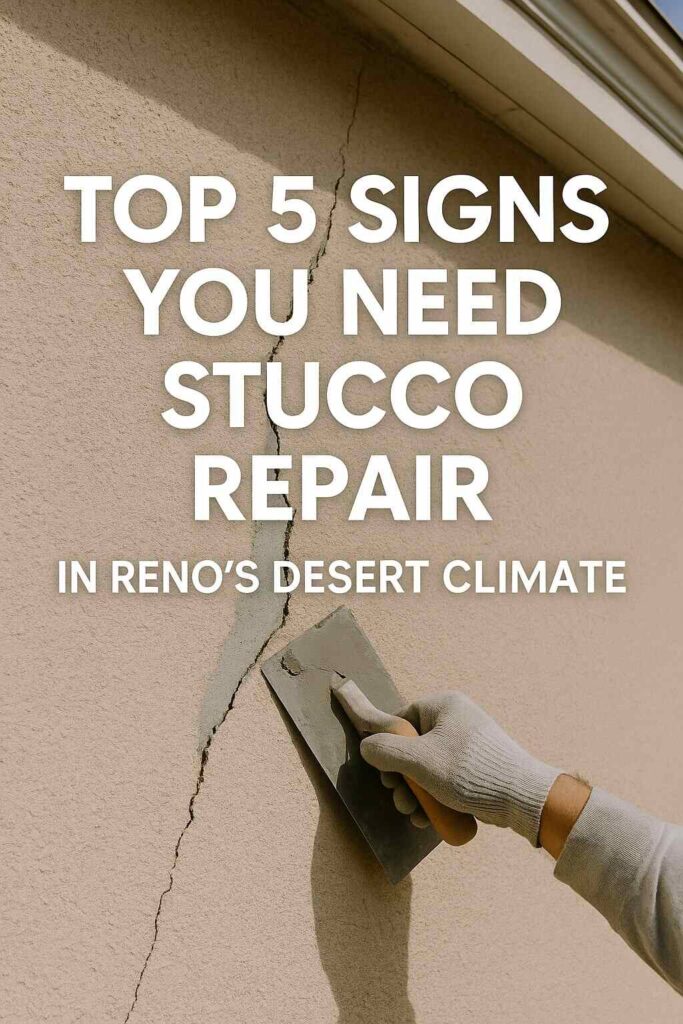Reno’s dramatic climate—scorching summers, chilly winters, and the occasional downpour—can be brutal on your home’s exterior. Stucco is a popular choice for Nevada homes because it’s tough, energy-efficient, and looks great… until it doesn’t.
Over time, even the most durable stucco starts to show wear and tear. And if you ignore the early signs, small cosmetic issues can turn into big structural repairs.
Here are five clear signs your stucco might need a professional fix:
1. Cracks That Weren’t There Before
Stucco naturally expands and contracts with temperature shifts. That’s why tiny cracks, especially hairline ones, are common in older homes. But in Reno, the daily swing from 100°F to cool desert nights speeds up that wear.
If the cracks are getting longer, wider, or appearing around windows and doors, take note. These are typically the first entry points for water. And once moisture gets under the surface, the damage happens fast.
Pro Tip: A yearly visual check of your stucco can catch cracks before they spread.
2. Stains or Discoloration
If you’ve spotted brown streaks or greenish blotches, you’re likely dealing with a moisture problem. Even though Reno is dry, poor sealing or drainage can let rainwater soak into the stucco—and it doesn’t dry fast once it’s in.
Discoloration usually shows up near gutters, vents, or where the roof meets the wall. Left untreated, this can lead to internal wall damage or mold growth.
Looking to seal and protect faded or stained walls? Consider a fresh coat from a local stucco painting specialist to extend your wall’s life.
3. Bubbling or Bulging Patches
This one’s easy to miss—until it isn’t. If your wall looks like it’s puffing out or developing bubbles under the surface, the stucco has likely detached from the wall behind it. That’s called delamination.
Reno’s heat can make moisture expand behind the wall, pushing the stucco outward. It’s not just cosmetic—it means the bond is failing.
These spots often lead to full wall section replacements if ignored too long.
4. Flaking or Soft Texture
When you touch the wall and it feels dusty or flakes off easily, that’s a clear sign the finish coat is breaking down. Years of sun exposure (especially on south-facing walls) dry out the surface and weaken the material.
This doesn’t just look bad—it exposes your walls to deeper issues like pest intrusion and insulation problems.
5. Interior Wall Issues
One of the most overlooked symptoms of failing stucco? What’s happening inside.
If your interior paint is bubbling, you smell a musty odor, or there are damp spots on your walls—your stucco might be the culprit. Water finds its way in through cracks and eventually soaks into insulation and drywall.
Don’t wait for your utility bills to spike or mold to spread.
What to Do If You Spot These Signs
Good news: most stucco damage is repairable if caught early.
Before you break out the DIY kit or ignore the problem altogether, consider calling a professional for an inspection. Trained eyes can detect whether it’s a surface issue or something deeper—saving you time, stress, and money.
If you’re in the Reno area and want honest advice, check out this stucco repair service in Reno for more details.
Final Thoughts
Your stucco does more than just make your home look good—it’s part of the structure that keeps your house dry, insulated, and protected. In Reno’s extreme climate, even small issues can become big problems fast.
So don’t ignore the signs:
-
Cracks
-
Stains
-
Bubbling
-
Flaking
-
Interior moisture
They’re all your home’s way of asking for help.
Found this helpful? Share it with a neighbor, or save it for your next home checkup.
Have questions about your own walls? Drop a comment or reach out—we’re always here to help!
